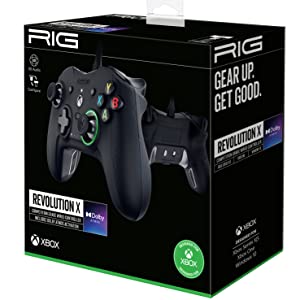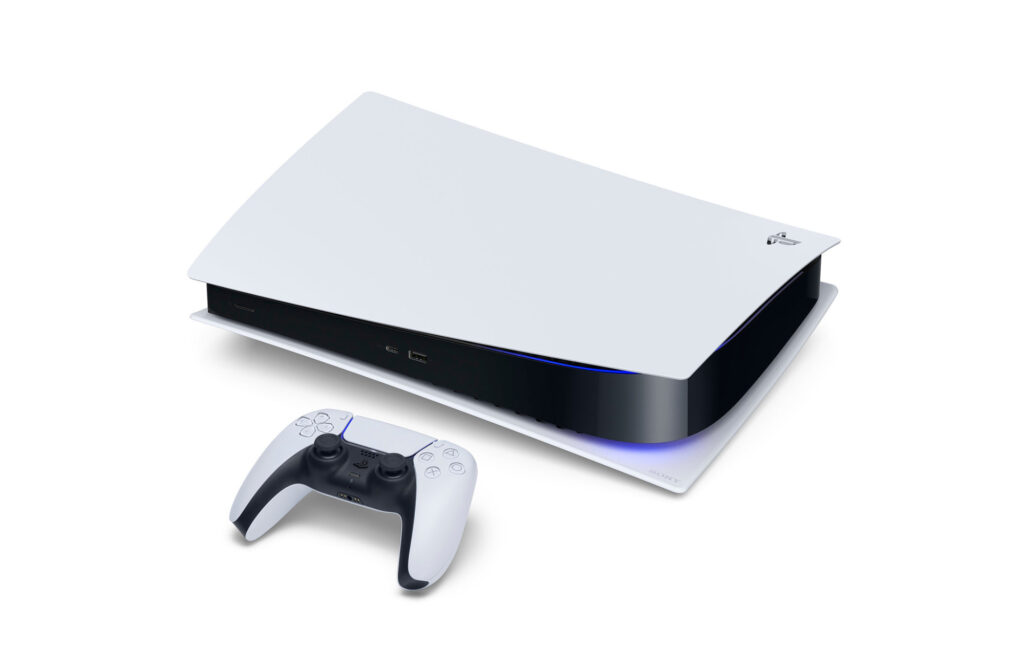

Hardware Info:
Nacon RIG Revolution X Pro Wired Controller
Black controller fully compatible with Xbox Series X|S, Xbox One, and Windows 10/11
3 Meter long USB-C cable included (approximately 10 feet)
Full rumble and impulse trigger rumble supported
Additional Xbox Series X|S Share button present
Four additional rear paddles which are programmable to any button
Swappable analog stick caps (concave and convex styles available)
Physically adjustable analog stick travel distance
Swappable weights for optimal comfort and balance, with 10g, 14g, and 16g weights
Four optional onboard and customizable profiles
Five EQ audio profiles to choose from, along with a custom five-band EQ
Dolby Atmos for Headphones included for Xbox or Windows
Microfiber cloth included
Storage case included
Price: $99.99
(Amazon Affiliate Link)
Thank you Nacon for sending us this controller to review!
Way back in 2015, Microsoft massively expanded the market for premium gamepad controllers with the release of the Xbox One Elite Controller. A few things made it special, though it was primarily the higher build quality, the four extra paddles on the back, and the insanely high price (current model is $179). While they did not invent back facing buttons (my Gravis Xterminator from the late 1990s had them), it certainly brought them to the forefront for many. It wasn’t long before third-party controllers started offering some form of paddles, though few used the exact design Microsoft did. Even now few copy MS exactly, but that doesn’t matter – we finally have controllers that can take advantage of the otherwise unused fingers holding our controllers comfortably in place in our hands.
When I first picked up the Nacon RIG Revolution X Pro, two things immediately jumped out. The first is unfortunately not the best – it doesn’t feel like it’s worth a hundred bucks. The plastic used is plenty sturdy, but the texture and finish doesn’t give the best first impression. The second thing that I quickly noticed is the unique stick and button design. However, once I actually spent time with it, I discovered that I like it – a lot.
For one thing, this is perhaps the most configurable controller out there. I don’t have every Xbox controller ever, but I haven’t seen anything like this before. On Windows (10+) and Xbox One/Series (tested on a Series X), there is a Microsoft/Xbox Store app called ‘Revolution-X’ that you can download to configure the four custom profiles that you can access by flipping a switch in the back from ‘Classic’ to ‘Advanced’ mode. Classic perfectly replicates a standard controller, with no additional features, except for the embedded Dolby Atmos for Headphones license. When it’s in Classic mode, the ring around the right analog stick glows a bright green. (I never found this glow to be a nuisance in use as a controller, but when I used it as my media controller while watching Netflix on my Xbox, it was bright enough to be distracting.) But it’s really Advanced mode, alongside this app, where the fun really begins.
First, I have to say that Nacon did one thing absolutely right – the profiles are all stored on the controller, so even if you use this controller on a non-Windows system (I tested it in Linux), all of the button reassignments work perfectly. As of this writing, only the built-in headphone jack (and of course Dolby Atmos, since that’s a software audio effect) on the controller doesn’t work with the excellent open source Xbox Linux controller driver xone. I don’t currently have access to a Mac to test it with that operating system.
Once you launch Revolution-X, it quickly becomes obvious that this was designed with a console in mind; it’s a full-screen application which is meant to be used entirely with a controller. It looks basically identical on Windows and Xbox. While it does waste a lot of screen space, it’s not too difficult to use. On the main menu, you can choose to manage profiles, or update the controller. When you update the controller, any changes are then stored on it. Managing profiles is where the meat of this app is. There are four default profiles, and you can make your own. The defaults are Nacon_Racing-Sports, Nacon_FPS, Nacon_Arcade-Fighting, and Nacon_Infiltration. Rather than go through the settings on each profile, I’ll instead go through what settings you can customize; these are just preset combinations.
Highlights:
Strong Points: Excellent functionality and flexibility well above most controllers; sticks and buttons feel great and are very responsive; Revolution X software allows a ton of customization, from axis ranges to button remapping, to EQ settings and more; Dolby Atmos for Headphones is a nice bonus; build quality is better than it first appears
Weak Points: Doesn’t make the best first impression; wish it was wireless at that price; long controller cable barely fits in the included case
There are six tabs worth of customizations: Mapping, Left Stick, Right Stick, Triggers, Audio, and Advanced Settings. Mapping is simply a straight 1:1 button mapping for each button. While the Xbox Accessories app (on Windows and Xbox) does basic button remapping, this app allows not only normal button remapping, but also allows assigning the four buttons on the back. Left and Right stick menus allow you to do some really cool tweaking. First is the most basic (and perhaps important) setting, the response curve. The default is Linear, where if you push it a little, it moves a little, and if you push it a lot, it moves the same proportion to what you pushed it. There are other presets, and of course you can set your own. These include Reactive, Boosted, Immediate, and Ultra Reactive. And of course you can create your own, using two different points to create a custom curve. It’s entirely possible to make it so you can push it a little and have a lot happen, or the reverse. The Immediate profile has the controller act like you moved it a lot when moving it slightly – which is great for fighting games, if you insist on using an analog stick with one. Other important settings include a custom dead zone, a Y axis inversion toggle, and a general sensitivity setting of + or – that I’m not entirely sure what it does.
The Triggers tab allows you to specify the movement range of the trigger when it’s pressed. You can set the max range, as well as the minimum when it’s pressed at all. The way it works is that if you have the minimum set to say 33%, and the max to say 50%, then only 33%-50% of the movement range of the trigger responds to input; less than 33%, and it does nothing, and after 50% It’s completely maxed out so the game sees it as 100% movement. It’s completely customizable from 0%-100% with 1% increments, though the minimum can’t go above 33% and the max can’t go below 50%. It’s a really neat feature though; let’s say you like to hold the trigger slightly before firing, but the game is oddly coded to fire on the slightest click-in. This totally lets you do that! Or, if you want the triggers to quickly max out because you think they have too much travel, you can do that, too. Very handy!
The Audio tab allows you to customize how you hear things when using the headphone jack on the bottom of the controller. If you listen via another means, it does nothing. On this screen, you can choose one of five EQ profiles, or use a custom one. (Flat is a custom setting, if you don’t like the built-in ones.) You can also change if the profile enables Dolby Atmos by default or not, and you can tweak microphone gain, and disable or enable noise suppression. Being able to adjust the mic gain is really important, as different headset mics can operate wildly different from one another.
The final tab is ‘Advanced’, which allows you to modify a bunch of miscellaneous settings. These include hand grip and trigger vibration levels (or even turn them off), which is really nice. The glowing ring can be set to a variety or even a combination of colors, and you can also set how bright it is. This includes lighting effects if you are so inclined. The final settings are related to the sticks and D-Pad; you can swap the Left and Right sticks if you choose, and can make the D-Pad sensitive to four or eight directions. I would leave that at eight unless you are sure, as disabling diagonals can make certain game types difficult.
As you can see, this is a ton of customization. And with four on-board profiles, there are certainly no lack of options! I am extremely impressed with the amount of options offered here.

I should probably address the build quality and comfort, since you’re holding the thing the entire time you use it. The first impression of being ‘cheap’ is at least in part because of how light it is. It’s a well-known phenomenon that heavy things seems ‘nicer’ – so much so that many products actually add weights that have no functional value just to make them seem of higher quality. While it’s not the lightest controller I’ve used, it is a bit lighter than the stock controller. If you prefer a balanced controller, you can also add weights to the handles that really makes a huge difference in that way, even if it’s heavier. I personally prefer the 10g weights or none at all, as I prefer lighter things when holding them for a long time.
The main reason it feels ‘cheap’ is the finish of the plastic. Thankfully it’s comfortable enough, but it doesn’t feel premium, despite it being premium in many other ways. The triggers and D-Pad both have a smooth finish, which I didn’t expect to like at first, either. And the buttons are larger and flatter than a typical Xbox controller, and more closely resemble the Nintendo Switch Pro controller’s face buttons rather than what Microsoft normally puts out. And yet, despite the questionable first impressions, it’s crazy comfortable to use for long gaming sessions.
The plastic doesn’t make you sweat. The triggers and D-Pad, despite being fairly smooth, somehow never get slippery. The buttons are extremely responsive, and aren’t fatiguing when button mashing. While I normally prefer concave sticks with a textured edge like the Xbox ones have, I never felt like the controls weren’t smooth and perfectly accurate. The rear buttons could have better tactile feedback, and yet in use they always responded when I needed them. I can’t tell you why, exactly, but somehow I feel like I play better with this controller. Let me use an example.
While reviewing this controller, I picked up a game I haven’t played in a long time because I needed something that required serious button mashing. That choice was Ys Origin. I happened to be very close to the end with my Yunica save, but I’d never gotten around to beating it. My save was right before a difficult boss. After starting the game with this controller, I beat that boss in only a few tries! After that, I tried doing some leveling up and switching between this one and my Xbox One wireless controller that I often use. It was no contest – I found this one both more comfortable, and strangely enough more accurate than the first-party Xbox controller. I also found a wonderful use of the rear buttons. You see, in that game, you can use your magic attack with X, do a normal attack with A, and jump with B. Performing jumps while holding X to do a charged attack while jumping is nearly impossible! And yet, the back buttons on the Revolution X Pro makes this simple. Excellent! On top of that, I felt like the very smooth motion thanks to the metal analog stick ring, and the really nice buttons meant that my thumb didn’t get tired as quickly, either. (Yes, these hands are getting older.) I have a strong suspicion that I’ll be using the Revolution X Pro with future action games; I’m very impressed.
The controller also comes with a carrying case, a nice microfiber cloth, a small box with weights and analog stick parts inside, and a very long cable. The case is really nice, but the pouch in there for the cable is a bit too small, and requires force to get it in there. Otherwise, it’s plenty nice and will protect your controller from accidental drops. I found that the default stick parts choice to be the best; I don’t see a reason to physically shorten my movement range on my analog sticks, but it’s an option if you want it. I also prefer the included concave sticks over the PS3-style convex ones, though again, if you miss that style of analog stick, it’s got you covered; in my experience, it’s one of the few controllers that offers a convex style analog stick at all, since most of the controller market has moved to the concave ridged edge design.
Overall, despite questionable first impressions, I really came to love the Nacon RIG Revolution X Pro controller. I do wish it was wireless, and at the premium price, perhaps it should be. But even still, if you need the level of customization that it offers, or if you want perhaps the smoothest analog stick movement out there thanks to the metal inner rings, or if you would like the larger Switch Pro Controller-style ABXY buttons on an Xbox controller, this one absolutely does the trick. At the very least, definitely watch for a sale – it’s a great controller that’s likely to please anyone who needs the utmost in customizability.




